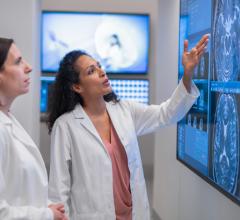
As another Breast Cancer Awareness Month comes to a close, Imaging Technology News is sharing excerpts from the October issue of the American College of Radiology (ACR) Bulletin, with applause to its expert authors who provided a historical overview of breast imaging and update on advocacy initiatives and cross-country 2023 legislation. Image courtesy: Getty Images
October 31, 2023 — As another Breast Cancer Awareness Month comes to a close, Imaging Technology News is sharing excerpts from the October issue of the American College of Radiology (ACR) Bulletin, with applause to its expert authors who provided a historical overview of breast imaging, including an update on advocacy initiatives and cross-country 2023 legislation.
The update, “100 Years of the ACR: The Evolution of Mammography” called attention to the significant evolution that the role of breast imager has taken over time. “Today, breast imaging radiologists play an active and critical role in the multidisciplinary team and comprehensive care of each breast cancer patient,” they wrote, and offered the following “in the pursuit to provide not only high-quality care but also equitable access to care for all our patients, particularly when it comes to mammography quality, access and reimbursement.”
Authors of the October 2023 ACR Bulletin article included: Amy K. Patel, MD, chair of the ACRA RAN and RADPAC; Geraldine B. McGinty, MD, MBA, FACR, former chair of the ACR BOC; and Stamatia V. Destounis MD, FACR, chair of the ACR Commission on Breast Imaging. Josh Cooper and Katie Keysor, ACR Government Relations staff members, who contributed to the article, for which a summary of article highlights follows.
In presenting an overview of early breast imaging and its evolution, the authors offered a brief but valuable summary of key advancements impact practice and practitioners today.
"Mammography screening has certainly come a long way since its inception. In the 1960s, mammography was performed using a general-purpose X-ray tube with images captured on direct exposure film and developed in a darkroom. There was no compression, and the images were low in contrast resolution. In the following decade, significant advancements were made with the introduction of screen-film mammography. Breast imaging technology continued to advance with the advent of dedicated mammography units during the 1980s and 1990s, leading to improved detection of breast abnormalities.
Uptake of mammography screening increased in response to the results of multiple randomized and controlled trials demonstrating the effectiveness of screening to reduce breast cancer death rates. Since 1990 , mammography has reduced the breast cancer death rate in the United States by nearly 40%. The development of effective pre-operative image-guided wire localization techniques was another pivotal innovation, which allowed a tissue diagnosis for suspicious lesions detected on mammography.
To support radiologists to report their findings in a structured manner, physician leaders in the ACR created a lexicon called the Breast Imaging Reporting and Data System (BI-RADS®). This is regularly updated to reflect current evidence-based practice.
Regulating Mammography
Increasing rates of mammography were unfortunately accompanied by wide variations in quality. The ACR was a leader in advocating for high-quality care through its 1987 Task Force on Breast Cancer Mammography Accreditation Program, which directly influenced Congress in the design of the 1992 Mammography Quality Standards Act (MQSA). The series of Congressional hearings dedicated to mammography that resulted in the MQSA imposed uniform national standards under the FDA that radiologists and breast imaging centers were and still are required to follow. These standards included providing high-quality images and interpretations as well as communicating findings and recommendations clearly to referring providers to ensure comprehensive patient care.
As a result of the ACR’s advocacy, the MQSA requires that all mammography facilities in the U.S., including those that examine Medicare or private pay patients and those that are only screening or diagnostic, be:
1. Accredited by an approved body. 2. Certified by the U.S. Department of Health and Human Services (HHS). 3. Inspected by the HHS or a state agency acting on behalf of the HHS.
These requirements have remained in place and are, in fact, becoming more stringent. In 2023, the FDA/MQSA issued an updated final rule, and all breast radiologists and centers need to comply with it by 2024. The new requirements center on quality reporting as well as breast density notification and are important to improve quality care for patients and referring providers.
Digital Breast Tomosynthesis
Digital mammography emerged at the turn of the century. This important advance moved breast imaging from a film to a digital environment, further enhanced tissue contrast and allowed image manipulation to improve diagnostic accuracy, especially for patients with dense breasts, while at the same time reducing radiation dose.
Breast imaging technology has continued to evolve, and in 2015 Medicare approved reimbursement for digital breast tomosynthesis (DBT). DBT involves the acquisition of multiple low-dose mammographic projections through the breast, which are reconstructed as a set of tomographic images. DBT has been shown to reduce false-positive findings, reducing call-back rates. It has also been found to improve the detection rate of invasive cancers, especially for patients with dense breasts.
Approximately 85% of U.S. facilities are now using DBT, and the ACR has deemed DBT as ‘no longer investigational.’ The multicenter randomized controlled TMIST trial, which is led by ACR Chief Research Officer Etta D. Pisano, MD, FACR, and administered through the ACR’s Center for Research and Innovation is recruiting a uniquely diverse cohort of patients to determine the benefit of DBT compared to digital mammography.
We have come such a long way as a profession when it comes to offering high-quality breast imaging. The ACR has and will continue to play an integral role in the care of our patients in our pursuit to ensure we are saving the most lives and improving the quality of life in patients with breast cancer through early detection."
Breast Health Measures Enacted in 2023 State Legislative Sessions
Also in the October ACR Bulletin article on breast imaging, mammography and legislative achievements.
The authors offered the following summary of legislative updates from 11 states.
"In 2023, several state legislatures took significant steps to enhance access to breast cancer diagnostic examinations and supplemental imaging services, aiming to alleviate or eliminate cost-sharing requirements for patients and ensure equitable coverage for essential breast health services. Each state's radiological society collaborated with various stakeholders in support of these initiatives. Many measures underscored the need to expand insurance coverage beyond mammogram screenings, as recommended by the American Cancer Society, particularly for high-risk patients and individuals with dense breast tissue. Without such coverage, the costs of supplemental examinations or follow-up diagnostic screenings can become prohibitively high, discouraging individuals from seeking potentially lifesaving tests. Here is an overview of the key bills related to breast health that were enacted in 2023:
Arizona
AZ SB 1601 updated recommendations for breast examinations and cancer screenings in the current statute, with a focus on early detection and diagnosis. It also updated definitions to ensure that individuals at higher risk for breast cancer, whether due to genetic factors, family history or breast tissue density, have access to a broader range of screening methods, and that the timing and frequency of these screenings follow established guidelines from authoritative sources like the National Comprehensive Cancer Network.
Delaware
DE HB 60 requires that all insurance policies issued or renewed in Delaware include coverage of supplemental and diagnostic breast examinations on terms that are at least as favorable as the coverage of annual screening mammograms. The act covers all group, blanket and individual health insurance policies, as well as the state employee healthcare plan and Medicaid.
Georgia
GA HB 315 empowers the Commissioner of Insurance to establish rules and regulations governing cost-sharing requirements for diagnostic and supplemental breast screening examinations.
Maryland
MD HB 376 and MD SB 184 prohibit insurers from imposing co-payments, coinsurance, or deductible requirements for diagnostic and supplemental breast examinations. MD HB 376 defines diagnostic breast examination as a medically necessary evaluation of the breast, which includes examinations using diagnostic mammography, breast magnetic resonance imaging or breast ultrasound. Supplemental breast examination is defined as a medically necessary breast screening when there are no prior abnormalities but there is a personal or family medical history or additional risk factors. The new law calls on the Maryland Health Care Commission to study and report to the governor, the Senate Finance Committee, and the House Health and Government Operations Committee about the financial impact of eliminating health insurance cost–sharing for diagnostic image-guided biopsies for breast cancer.
Montana
MT HB 665 revises insurance coverage related to breast examinations, emphasizing equitable access to diagnostic breast examinations using various methods and updates definitions for diagnostic breast examination and supplemental breast examination. The definition of diagnostic breast examination now encompasses examinations performed using diagnostic mammography, breast magnetic resonance imaging or breast ultrasound. The definition of supplemental breast examination also now encompasses examinations performed using breast magnetic resonance imaging or breast ultrasound.
New Mexico
NM HB 27 requires coverage for diagnostic and supplemental breast examinations without cost sharing, promoting access to medically necessary and appropriate breast examinations.
North Dakota
ND SCR 4009 - Study Bill directs Legislative Management to consider studying whether health insurance should provide coverage for diagnostic and supplemental breast examinations without imposing cost-sharing requirements. Legislative Management is tasked with reporting findings and recommendations, together with any legislation required to implement the recommendations, to the next session’s Legislative Assembly.
Oregon
OR SB 1041 prohibits health benefit plans that reimburse the cost of diagnostic or supplemental breast examinations from imposing a deductible, coinsurance, copayment, or other out-of-pocket expense for a medically necessary diagnostic or supplemental breast examination. Key terms, including "diagnostic breast examination" and "supplemental breast examination" are defined. Diagnostic breast examinations encompass examinations that evaluate breast abnormalities detected or suspected during breast cancer screening, and these examinations can include diagnostic mammography, breast magnetic resonance imaging or breast ultrasound. Supplemental breast examinations involve breast screenings for individuals with no suspected abnormalities, based on personal or family medical history, or risk factors for breast cancer. This is effective beginning Jan. 1, 2024.
Rhode Island
RI HB 5283 mandates insurance coverage for any additional screenings deemed medically necessary for individuals who have received notice of dense breast tissue. Notably, the policies must cover two screening mammograms per year when recommended by a physician for women who have been treated for breast cancer within the last five years or are at high risk due to factors such as genetic predisposition or dense breast tissue. Additionally, other medically necessary screenings, such as magnetic resonance imaging or ultrasound, must be covered for individuals with dense breast tissue.
Tennessee
TN SB 365 and TN HB 355 require health benefit plans to provide coverage for diagnostic imaging and supplemental breast screening without imposing cost sharing on the patient. "Cost-sharing requirement" is defined to encompass deductibles, coinsurance, copayments and maximum limitations on these out-of-pocket expenses. The law went into effect on August 9.
Washington
WA SB 5396 addresses cost sharing for diagnostic and supplemental breast examinations, promoting access to diagnostic breast imaging services without financial obstacles. Except for grandfathered plans, the measure stipulates that health carriers may not impose cost sharing requirements. Additionally, "diagnostic breast examination" is defined as a medically necessary and appropriate examination of the breast, which includes diagnostic mammography, digital breast tomosynthesis (three-dimensional mammography), breast magnetic resonance imaging, or breast ultrasound, and is used to evaluate an abnormality that is either seen or suspected based on a screening examination for breast cancer, or detected through another means of examination.
"Supplemental breast examination" refers to a medically necessary and appropriate examination of the breast. This type of examination includes breast magnetic resonance imaging or breast ultrasound, and is used for two primary purposes: to screen for breast cancer when there is no abnormality seen or suspected in the breast, or be based on personal or family medical history or additional factors that may increase the individual's risk of breast cancer.
These legislative actions represent significant progress at the state level in removing barriers to breast cancer screening and diagnosis, with state radiological societies playing a pivotal role in collaborating with stakeholders and legislators in their respective states. It is anticipated that the 2024 legislative session will see additional states pursuing similar measures in this ongoing effort."
The American College of Radiology (ACR), which is commemorating its 100th anniversary this year, headquartered in Reston, VA, represents nearly 41,000 diagnostic radiologists, radiation oncologists, interventional radiologists, nuclear medicine physicians and medical physicists. Founded in 1923, ACR now has 54 chapters (50 states, DC, Canada, Puerto Rico and CARROS — Council of Affiliated Regional Radiation Oncology Societies).
More information: www.acr.org


 July 30, 2024
July 30, 2024 








